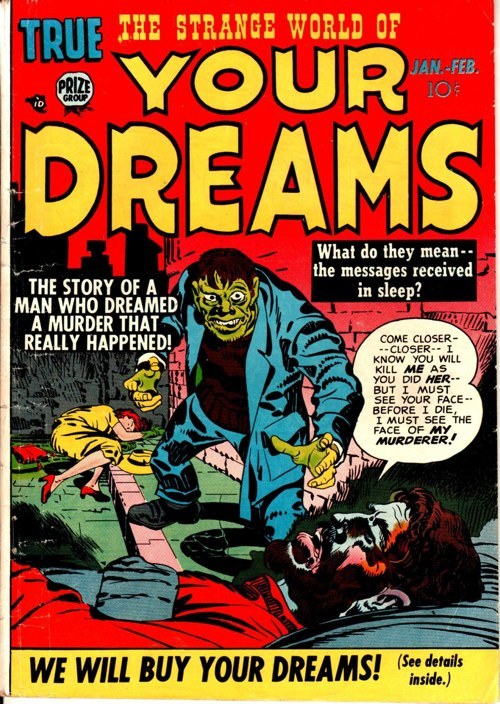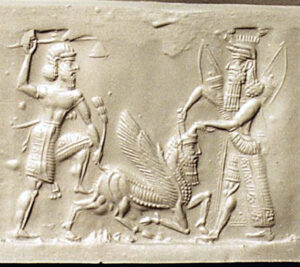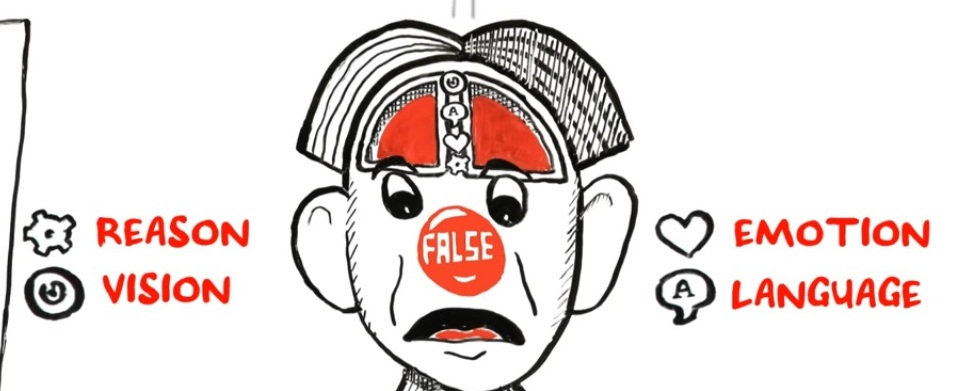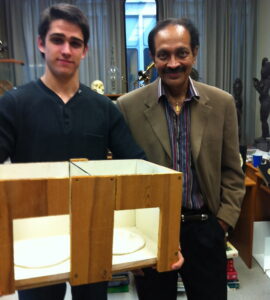
In September of 1913, Carl Jung, the great pioneer of depth psychology, was on a train in his homeland of Switzerland when he experienced a waking vision. Gazing out the window at the countryside, he saw Europe inundated by a devastating flood. The vision shocked and disturbed him. Two weeks later, on the same journey, the vision reoccurred. This time an inner voice told him: “Look at it well; it is wholly real and it will be so. You cannot doubt it.”
Years later, in his memoir Memories, Dreams and Reflections, he recalls the event and his concern that he was having a psychotic break.
“I was suddenly seized by an overpowering vision: I saw a monstrous flood covering all the northern and low-lying lands between the North Sea and the Alps. When it came up to Switzerland I saw that the mountains grew higher and higher to protect our country. I realized that a frightful catastrophe was in progress. I saw the mighty yellow waves, the floating rubble of civilization, and the drowned bodies of uncounted thousands. Then the whole sea turned to blood.”
The following spring of 1914, he had three catastrophic dreams in which he saw Europe was deluged by ice, the vegetation was gone, and the land deserted by humans. Despite his awareness that the situation in Europe was “darkening,” he interpreted these dreams personally and feared he was going mad. However, by August of that year, his dreams and visions were affirmed: World War I had broken out.

Some fifty years earlier, President Abraham Lincoln had a prophetic dream. Three days before he was assassinated, Lincoln conveyed his dream to his wife and a group of friends. Ward Hill Lamon, an attending companion, recorded the conversation.
“About ten days ago I retired very late. I had been up waiting for important dispatches from the front. I could not have been long in bed when I fell into a slumber, for I was weary. I soon began to dream. There seemed to be a death-like stillness about me. Think I heard subdued sobs, as if a number of people were weeping. I thought I left my bed and wandered downstairs. There the silence was broken by the same pitiful sobbing, but the mourners were invisible. I went from room to room; no living person was in sight, but the same mournful sounds of distress met me as I passed along. It was light in all the rooms; every object was familiar to me; but where were all the people who were grieving as if their hearts would break? I was puzzled and alarmed. What could be the meaning of all this? Determined to find the cause of a state of things so mysterious and so shocking, I kept on until I arrived at the East Room, which I entered. There I met with a sickening surprise. Before me was a catafalque, on which rested a corpse wrapped in funeral vestments. Around it were stationed soldiers who were acting as guards; and there was a throng of people, some gazing mournfully upon the corpse, whose face was covered, others weeping pitifully. ‘Who is dead in the White House?’ I demanded of one of the soldiers. ‘The President,’ was his answer; ‘he was killed by an assassin.’ Then came a loud burst of grief from the crowd, which woke me from my dream. I slept no more that night; and although it was only a dream, I have been strangely annoyed by it ever since.” (Recollections of Abraham Lincoln, 1847-1865 by Ward Hill Lamon, published 1911.)
Two weeks later, on April 14, 1865, Lincoln was assassinated by John Wilkes Booth. As in his dream, his casket was put on view in the East Room of the White House and guarded by soldiers.
These are two chilling examples of dreams that occurred during periods of collective crisis which accurately predicted historical turning points. Do prophetic dreams occur more often during turbulent times? How does the dreamer know if a dream is to be interpreted personally and symbolically, or as a warning for others and the world at large?
I asked these questions to Dr. Murray Stein, a renowned author and Jungian analyst at the International School for Analytic Psychology in Zurich, Switzerland. Dr. Stein replied that he had no statistics on whether people have predictive dreams more frequently in times of crisis than at other times. In his experience, one can’t know if a dream is precognitive until after the event. After 9/11, he told me, people reported precognitive dreams that foretold the disaster. He said people also reported that dreams foretold the financial crisis of 2008, which he called, “a black swan event.” According to Investopedia:
A black swan is an unpredictable event that is beyond what is normally expected of a situation and has potentially severe consequences. Black swan events are characterized by their extreme rarity, their severe impact, and the practice of explaining widespread failure to predict them as simple folly in hindsight.
The recent outbreak of the coronavirus might be considered a black swan event, and perhaps we will soon hear about people who have had prophetic dreams of its manifestation.
 While there is no simple answer or proven method to discern whether a dream should be interpreted personally or more broadly, we can go about exploring its contents with both aspects in mind. For example, if I have a dream in which I am a child who has been put into a cage. I might ask: What aspect of me feels “caged” right now? Noting that I am a child in the dream, I might further inquire: Is there something from my childhood that is still confining and constricting me? I might try to estimate the age of the child in the dream and reflect back to when I was that age and try to remember if something significant happened then. Maybe my parents had begun to think about divorce at that time and I felt caged by their emotions. I might then inquire if there is something similar going on in my life right now, not necessarily a divorce, but an imminent disruption or the loss of a treasured relationship. When we go back into a dream to amplify it, each question generates other questions that can lead to deeply buried insights. (For a more complete explanation of Jung’s use of amplification as a technique, please see Michael Vannoy Adams’ description on JungNewYork.
While there is no simple answer or proven method to discern whether a dream should be interpreted personally or more broadly, we can go about exploring its contents with both aspects in mind. For example, if I have a dream in which I am a child who has been put into a cage. I might ask: What aspect of me feels “caged” right now? Noting that I am a child in the dream, I might further inquire: Is there something from my childhood that is still confining and constricting me? I might try to estimate the age of the child in the dream and reflect back to when I was that age and try to remember if something significant happened then. Maybe my parents had begun to think about divorce at that time and I felt caged by their emotions. I might then inquire if there is something similar going on in my life right now, not necessarily a divorce, but an imminent disruption or the loss of a treasured relationship. When we go back into a dream to amplify it, each question generates other questions that can lead to deeply buried insights. (For a more complete explanation of Jung’s use of amplification as a technique, please see Michael Vannoy Adams’ description on JungNewYork.
But what if I dream that I am a child that has been put into a cage, and a few days later I discover that children of immigrants are actually being held in cages in detention centers? My dream, while personally relevant, would carry a collective, or more public meaning as well. This collective meaning of the dream attests to the interconnectedness of our species, to our capacity for empathy (we see a horror on the news and we feel it enter us) and to the common values we share about the quality of human life.
If we had lived during the early part of the last century, or in an indigenous culture, or in ancient Mesopotamia, we might examine our dreams for deep wisdom and as augurs for the future. These days we are more likely to look to neuroscience to understand of our dreams. Neurobiology tells us that sleep is a complex neural activity of the brain that stays busy activating and deactivating complicated neuro-systems while we doze, including consolidating memories, regulating mood, restoring immune function and many other important utilitarian tasks. But neuroscience tells us nothing about the meaning of dreams or why our dreaming life has carried significance for humans since we first walked the planet.
 About thirty thousand years ago, toward the end of the Paleolithic Era, our hunter-gather forebears descended into the subterranean darkness of caves to enact rituals of trance and dreaming. Recently, archaeologists and ethnographers have speculated that the artifacts found in the caves of southern Europe— bone flutes, whistles, and types of drums—and the now-famous discovery of cave wall paintings indicate that ancient shamans may have used these caves for ceremonial dream retreats (See in particular the work of David Lewis-Williams). We can speculate that the depictions of bison and large and small game along with scenes of hunting painted on the walls may reflect shamanic dream content. Perhaps the shaman ascended from his retreat having had visions about the abundance and location of prey, which would be crucial information for the clan.
About thirty thousand years ago, toward the end of the Paleolithic Era, our hunter-gather forebears descended into the subterranean darkness of caves to enact rituals of trance and dreaming. Recently, archaeologists and ethnographers have speculated that the artifacts found in the caves of southern Europe— bone flutes, whistles, and types of drums—and the now-famous discovery of cave wall paintings indicate that ancient shamans may have used these caves for ceremonial dream retreats (See in particular the work of David Lewis-Williams). We can speculate that the depictions of bison and large and small game along with scenes of hunting painted on the walls may reflect shamanic dream content. Perhaps the shaman ascended from his retreat having had visions about the abundance and location of prey, which would be crucial information for the clan.
Later human societies continued to transcribe their dreams. The oldest written dream recorded is in the Sumerian epic poem of Gilgamesh (2100 BCE). Not unlike King Nebuchadnezzar’s frightening dream in the Book of Daniel, Gilgamesh, the king of the Sumerian city Uruk, has violent nightmares about death, which shake him to the core, and send him on his quest for immortality. But Gilgamesh cannot interpret his own dreams, and like many of the dreamers in the Old Testament, is in need of an interpreter. How telling that from ancient times, the one who receives the dream and the one who knows its significance are different people.
 In some contemporary cultures, dreams are thought to be a way of receiving messages from the spirit world. A holy man or medicine woman, an elder or shaman is the receiver of the prophetic dream, which is given for the benefit of all and linked to the survival of the tribe or people. Black Elk, the holy medicine man of the Lakota Sioux, stated this when he said a dream is worthless unless it is shared with the tribe.
In some contemporary cultures, dreams are thought to be a way of receiving messages from the spirit world. A holy man or medicine woman, an elder or shaman is the receiver of the prophetic dream, which is given for the benefit of all and linked to the survival of the tribe or people. Black Elk, the holy medicine man of the Lakota Sioux, stated this when he said a dream is worthless unless it is shared with the tribe.
How can we relate to the dreams that pursue us? Are they simply the result of complex neurological activity and without real meaning, just as we know the moon is no enchanted sphere but a mere rock in space? What might we miss if we cast our lot with a viewpoint based wholly on the material world? Is it possible to consider the two worlds as being equally meaningful, the world of science and — to borrow the phrase John Keats used to characterize adventurers on the threshold of a new frontier — the world of “wild surmise”? Can we think of ourselves as vessels open to receiving wisdom through non-ordinary means? Can we be our own shamans?
This post appeared in a slightly different form on Dale’s blog on Psychology Today. You can find all of Dale’s blog posts for Psychology Today at




